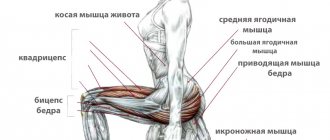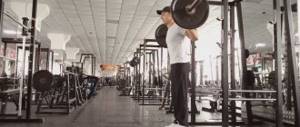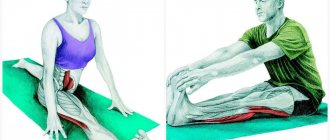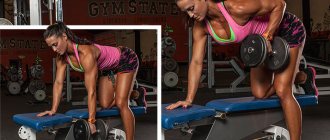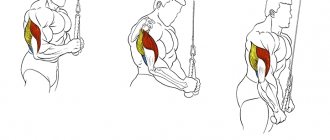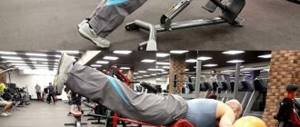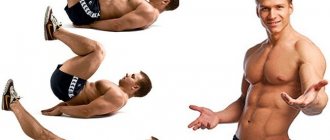What are back lunges?
The lunge is a knee-dominant exercise, meaning that the initial movement occurs at the knee. This is a unilateral exercise (performed on one side) and is more dynamic than the double leg squat, where both feet remain stationary.
When performing a reverse lunge, you will step back with one leg. You bend your back leg so that your back knee is almost touching the ground and your front knee is roughly parallel to the floor. Your front foot down is the one that will work.
Workout Features
If the goal of the exercise is to increase the hip area, then a narrow step is necessary.
When you want to pump up the buttocks area, you need to take long steps. Then the angle at the knee of the supporting leg will be more than 90°. The low squat helps stretch the gluteus maximus and hamstrings.
The fair sex needs to do many repetitions to achieve weight loss - at least 20 (2-3 approaches). To build muscle strength, exercises are performed with weights 10-15 times. If you have a gym membership, you should use the Smith machine. For better growth, the training program also includes squats and other exercises.
What muscles work
Back lunges are a great strengthening exercise. They work the quads, glutes, hamstrings and calves.
However, when doing forward lunges, you tend to work your quads more than your glutes. And when you do reverse lunges, you tend to work your glutes a little more.
Other types of exercises
A slightly more complicated option is amplitude lunges. They are performed when the angle formed at the knee of the bent leg is already more than 90°. At the same time, the leg remains almost straight. This adds amplitude to the exercise, and the thigh drops lower, allowing the muscles to stretch even more.
Another type of lunge is lunges in one place. Here you no longer need to take steps and put your legs in and out. Starting position - the right leg is put forward, the distance between the feet is approximately 40-50 cm. The heel of the left leg is raised, does not touch the floor. The technique here is practically no different from the previous types. It is necessary to bend your left leg at the knee, reaching it to the floor. In this case, the body leans forward, but the lower back should not round. Move your pelvis back, while again making sure that the heel of your left foot remains in its original position.
It is possible to perform lunges with the foot turned inward. This placement of the feet allows you to better feel the gluteus medius muscle and the outer side of the thigh. The rules described earlier also apply to this exercise, except that the toe of the right foot should be turned inward. The left leg needs to be held slightly askew. All this is necessary for maximum tension in the thigh muscles.
Don’t forget about such an exercise as side lunges. With their help, the gluteal muscles are also worked as efficiently as possible. Execution technique: lunge with one leg to the side, the pelvis is pulled back (as if you are sitting on the tip of a chair placed far away), while the body leans forward . In this case, you can stretch your arms out in front of you, connecting them while squatting into a lock.
When performing this or that exercise, you need to ensure that all recommendations are followed as accurately as possible. In the initial stages, you can return to the starting position by pushing off the floor with almost your entire foot. However, if possible, try to transfer your body weight to your heel and strive for this with each new approach. As a result, the effectiveness of the exercises will reach its maximum. This kind of exercise will charge you with energy for the whole day, making your legs stronger and more beautiful.
Within the walls of the “YourRevolution1905” club, we are ready to professionally help you tighten your body and improve your physical shape. Whole sets of exercises developed by certified specialists, nutritional recommendations, “smart” weighing and much more, all this will help you achieve your goal as effectively as possible. For the most effective and quick results, you can train individually (one-on-one with a trainer) or in mini-groups of up to ten people. Come to our classes and we will help you become the best version of yourself!
Execution technique
- Stand with your feet shoulder-width apart.
- Step back with your right foot, landing on the ball of your right foot and keeping your right heel off the ground.
- Bend both knees to 90 degrees. Focus on keeping your core tight and your hips tucked in (don't stick your butt out). Sometimes it can be helpful to place your hands on your hips to make sure they are not leaning to the side, forward or back.
- Push through the heel of your left foot to return to the starting position.
You can do all reps in a row or alternate sides
Basic mistakes
- Tilt of the body forward and backward;
- Amplitude too small;
- Artificial reduction in step length;
- Bringing the knee behind the toe line;
- Shifting the center of gravity from heel to toe;
- Narrow feet in the starting position;
- Parallel feet;
- Pushing the toe off the floor.
How do these lunges differ from regular ones, and their other variations?
The technique of the exercise itself differs only in a few points of movement, but everything is the same. But these distinctive points are precisely the features of the exercise. First of all, you will have to step backwards rather than forwards, which is not entirely convenient for a person due to his body structure. Therefore, you have to monitor the balance of the body, and this already involves the stabilizer muscles responsible for balance, and you have to make efforts to clearly coordinate the actions of the body. Already a plus. Further.
If forward lunges can be done without returning the front leg to its original position (we step forward with our foot and do lowering/raising in the lunge until the end of the set), then in backward lunges you will have to return the back leg to its original position, because then the meaning of the exercise is lost.
It is also worth noting that the muscles of the legs and buttocks are tensed differently in this exercise. This can be noticed if you constantly “hammer” forward lunges, get used to them, and then switch to backward lunges - the same working muscles will hurt at first due to the unfamiliarity of the load.
As for another variation of these lunges, I will say one thing: they can be done with steps backwards, that is, do not put the leg pointed back to the one standing in front, but do another lunge backwards with the one standing in front, and so on. A similar exercise should be done after mastering the technique of simple backward lunges, because for an untrained person the technique of backward lunges in a step can be “crooked”. Then what's the use of it?
But on the other hand, this exercise in a more complex variation will simply incredibly “explode” your buttocks, dear girls, and I’m generally silent about how your legs will be loaded.
Contraindications
All contraindications to performing back lunges in place come down to the health status and individual characteristics of each athlete. Physical exercise has no generally accepted contraindications. This is one of the “home” movements that a person does every day (for example, tying his shoelaces). However, due to the stress on some areas, lunges may not be advisable in the following cases:
- For knee injuries.
- For hernias of the lumbar spine in the acute stage.
- For arthrosis of the knee joint.
- Exercise is also not recommended for people who are prescribed limited movement (for example, recovering from surgery).
Let's start training
Regardless of the weight with which you do back lunges, the execution technique remains virtually unchanged:
- Stand straight, keep your feet shoulder-width apart. Keep your back straight, look straight ahead, this makes it easier to maintain balance.
- As you inhale, take your leg back and lower yourself as low as possible to the floor, but without touching it with your knee.
- As you exhale, rise up and slowly return your leg to the starting position.
- Do 10-15 repetitions on one leg, then on the other.
- The optimal number of approaches is 3-4.
If you perform backward lunges with dumbbells, then hold them at your sides with outstretched arms; if with a barbell, then hold them on your shoulders, just like with classic squats. For convenience, when lunging with a barbell, it is better to place the equipment on racks rather than on the floor - this will not only save time, but also reduce the load on the spine, since with large weights you can easily get injured by simply bending incorrectly to place the barbell on floor.
You can perform the exercise statically, without bringing your leg back, but in this case it will take much more effort to correctly distribute the load.
What equipment can be used
You can do reverse lunges with dumbbells or kettlebells, holding them at your sides or horizontally. If you have access to a barbell, you can also do reverse lunges in the same way, but make sure you master all the other variations first.
Back lunges with dumbbells
Back lunges with barbell
Back lunges with kettlebell
Back lunges with a fitness band
Working muscles
Back lunges, as well as other variations of this exercise, maximally load the quadriceps (the muscles of the front of the thigh) and gluteus maximus muscles. The exercise itself is used to shape the legs and round the buttocks.
Additionally, the hamstrings, calf muscles, abs and spinal extensor muscles work. A significant amount of effort is spent on maintaining the body in a stable position, which is why the exercise is called coordination complex.
As for safety, it is worth saying that when performing lunges, the knee joint in front (the working leg) experiences increased load. Therefore, people with bad knees are not recommended to practice the exercise. If you do back lunges with dumbbells or a barbell, the lumbar spine is also at risk. In order to protect yourself from back injuries, you should strictly follow the exercise technique. It will be discussed further below.
In general, the skill of correctly performing lunges comes after several training sessions, so it is recommended to practice the first sessions without weights. This is necessary in order to feel the movement and improve coordination.
What is the difference between backward lunges and forward lunges?
Both forward lunges and reverse lunges are excellent exercises for strengthening one leg, making them a useful tool for identifying and correcting any muscle imbalances that may arise between the right and left sides.
But there are several important differences between the two types of lunges. First, the reverse lunge is generally more beginner-friendly because it requires much less stability than the forward lunge.
When performing forward lunges, the forward step is the main driver of strength. You need your glutes, hamstrings, quads, and other front leg muscles to slow you down and then bring you back to the starting position. And in a reverse lunge, the stationary leg is the main engine of force, making it easier to control.
Tip: The most effective is considered to be alternating different techniques over weeks or workouts.
Variations
In addition to the classic version of the movement, there are many more variations that you can use to diversify your workouts.
- Back lunges from a step. Place your working foot on a step or step platform, and step onto the floor with your supporting foot. This version of the exercise better stretches the gluteal muscles and increases the load.
- Lunges alternately with the right and left legs. A good dynamic option for fat burning.
- Lunges in place. This variation of the exercise is convenient when working with weights. In this case, you do not take steps with your feet, but simply stand in a stepwise position and perform squats. This exercise is also called scissor squats.
For high-quality training of the legs and buttocks, the load on the muscles must be complex and varied. Use various exercise options in your program, exercise regularly, and do not forget about nutrition and rest after training. Let working on your body bring pleasure and good results!
Types of lunges
There are three main types of performing this exercise. The first is reverse lunges, which use only your body weight. However, this movement is performed only by beginners. Slightly more experienced athletes use the second, most common option - lunges with dumbbells. The third method is considered the most difficult, since instead of dumbbells, a barbell is used for weights. Naturally, you can hang the maximum possible load on it, while dumbbells exist only with a certain weight, and it may not be enough for already experienced athletes.
It can be added that the second version of the exercise is most often used by girls, since the weight of dumbbells is less, but the third method is more often performed by men, since with a barbell you can achieve maximum load on the muscles.
Lunges with back leg on a stand (Bulgarian)
Similar to the previous option, but the back leg is placed on the stand. And here we need a higher stand. A regular horizontal bench will work well. With this option, the load falls almost entirely on the front (working) leg. And the back leg simply serves to maintain balance. In this case, you won’t be able to squat low and stretch your buttock too much. That is, the load will fall more on the thigh rather than on the buttock. This option is also more suitable for those who are gaining weight. But I would call this option “for everyone.” It is quite difficult to do, and it does not provide any unique advantages.

